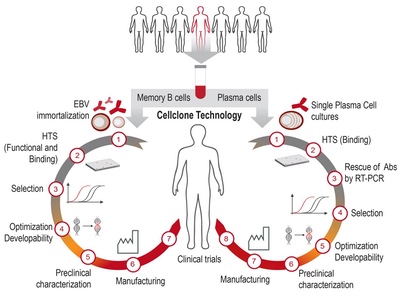The work to determine the sensitivity and specificity of the assay was a collaborative effort involving laboratories in five countries — Nicaragua, Brazil, Italy, the UK and Switzerland.
Professor Eva Harris coordinated with her collaborators in Nicaragua to provide very well characterised samples from the unique long-term studies conducted jointly, which enabled critical evaluation of the assay using multiple time-matched samples from Zika patients with or without prior exposure to dengue virus alongside samples from dengue patients infected once or more than once with different dengue virus serotypes.
The results indicated that this novel test, derived from Humabs' CellClone technology, was highly sensitive, specific and robust.

Dr Davide Corti
Dr Davide Corti, Chief Scientific Officer of Humabs BioMed, said: "These results support that the antibody-based assay that we have developed is highly effective in detecting both recent and past Zika virus infections and in discriminating Zika from other flavivirus infections. This novel assay has the potential to become an effective, simple and low-cost solution for Zika surveillance programmes, prevalence studies and clinical intervention trials in flavivirus-endemic areas."
Professor Harris, Division of Infectious Diseases and Vaccinology, School of Public Health, University of California, Berkeley, said: "It is very exciting to finally have a robust, high-throughput assay with such high sensitivity and specificity to distinguish Zika virus infections in dengue-endemic countries; we have already applied it to large age-stratified serosurveys and spatial analysis of Zika virus infection in Nicaragua, advancing scientific research while providing critical data to public health authorities in real time."
Zika virus has turned into a public health threat, particularly due to its association with severe congenital birth defects. The high level of cross reactivity among flaviviruses and their co-circulation has made the use of serological assays to detect infection challenging.
While today a number of assays do exist, their ability to detect Zika except in a very small window of time and to differentiate it from other flaviviruses is limited.
This has made it very difficult to accurately determine the prevalence of Zika infections, the incidence of congenital Zika syndrome in babies born to infected women, as well as to identify neurological complications associated with Zika virus infections.
Utilising its proprietary CellClone discovery technology, Humabs generated a ZIKV nonstructural protein 1(NS1)-specific human monoclonal antibody, which the company then used to develop the assay. The assay is a competitive ELISA format and is based on measuring the presence of plasma or serum antibodies in immune individuals that are able to block the binding of a labelled monoclonal antibody to coated Zika virus NS1.
The assay is named NS1 blockade-of-binding (BOB) ELISA and was tested using a large panel of well-characterised clinical samples from travellers and patients living in areas with a high level of exposure to Zika virus and endemic for other flaviviruses.

Testing was conducted in several laboratories in both Latin America and Europe. The results indicated that the test was highly sensitive, specific and robust. The assay is also cost effective and easy to use, designed to make it available in those areas of the world where it is urgently needed.
References:
- Angel Balmaseda, et al., "Antibody-based assay discriminates Zika virus infection from other flaviviruses," PNAS (2017)




